Karma, War and Inequality in Twentieth Century Japan
By Brian Victoria
Introduction
While “karma” is used so often in the West today that it has become almost a household word, surprisingly little attention has been paid to the socio-political role played by karma in Asian societies, past or present. In fact, it is no exaggeration to say that the very idea of karma having a socio-political role will come as a surprise to many. That is to say, how could an ethical concept like karma, commonly associated with the good or bad effects of an individual’s acts, play a role in collective entities like society and politics?
This article examines the socio-political use of karma in twentieth-century Japan, beginning with the Meiji Restoration of 1868. In doing so, however, it is important to realize that Meiji Buddhist leaders did not suddenly concoct a new interpretation of karma, for what they wrote had ample precedent in East Asian Buddhism. For example, at the conclusion of one of the most famous and influential Mahayana scriptures, the Lotus Sutra, we learn:
Whoever in future ages shall receive and keep, read and recite this sutra, such persons will no longer be greedily attached to clothes, bed things, drink, food, and things for the support of life; whatever they wish will never be in vain, and in the present life they will obtain their blessed reward. Suppose anyone slights and slanders them, saying “You are only madmen, pursuing this course in vain with never a thing to be gained.” The doom for such a sin as this is blindness generation after generation. . . . if anyone sees those who receive and keep this sutra, and proclaims their errors and sins, whether true or false, such a one in the present life will be smitten with leprosy. If he ridicules them, generation after generation his teeth will be sparse and missing, his lips vile, his nose flat, his hands and feet contorted, his eyes squint, his body stinking and filthy with evil scabs and bloody pus, dropsical and short of breath, and [with] every evil disease. (1)
Such, then, is the karmic fate of those who dare to criticize followers of the Lotus Sutra. And since their blindness, etc. will last “generation after generation,” it is clear that the blind, lepers, and physically deformed of this world have only themselves to blame for their afflictions. They had it coming!
In light of this understanding of karma, it is no wonder that when wedded to the Confucian-inflected familialism of East Asian countries, physical impairment has long been a source of shame not only for impaired individuals but for their entire family. Over the centuries, how many such individuals and families have had to endure discrimination, ridicule, isolation, harsh treatment and worse because of the alleged “evil” they committed in past lives?
Nor should we think that the above interpretation represents some uniquely Mahayanan aberration or an understanding of karma that can safely be understood (or dismissed) as a relic of Buddhism’s feudal past.
I vividly recall a conversation with a senior Thai monk during the 2001 conference of the International Association of Buddhist Studies in Bangkok. I asked the Venerable, “Why don’t Thai Buddhist leaders speak out against the rampant sexual slavery imposed on children in Bangkok and other Thai cities?” He replied, “You must understand that these girls did something evil in their past lives, perhaps committing adultery. That is why they ended up as prostitutes in this life. Of course, there is hope for them in their future lives.”
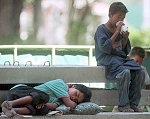
At-risk street children in
Bangkok
What I am about to describe as the socio-political use of karma in twentieth century Japan is nothing new, whether in Mahayana or Theravada Buddhism, past or present. Ultimately, this raises the critically important question of how Buddhism can hope to play a constructive, let alone compassionate, role in contemporary society if it cannot confront and overcome this understanding of karma.
Civilian Usage
Although the reactionary civilian and military use of karma went hand in hand in post Meiji Japan, I will first address the civilian, or at least non-military–related use of karma, before going on to explore its military use.
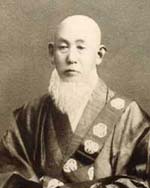
Shimaji Mokurai
Since the middle of the Meiji period, institutional Buddhist leaders of all sects employed the doctrine of karma in their ideological struggle against Western liberalism and individualism, not to mention anarchism, socialism, and communism. As early as 1879, for example, the noted Shin sect priest and scholar Shimaji Mokurai (1838-1911) wrote an essay entitled “Differentiation [Is] Equality” (Sabetsu Byodo). Shimaji asserted that distinctions in social standing and wealth were as permanent as differences in age, sex, and language. Thus, those struggling for social equality, most especially socialists and the like, were fatally flawed because they emphasized only social and economic equality. That is to say, socialists failed to understand the basic Mahayana Buddhist teaching that “differentiation is identical with equality” (sabetsu soku byodo). (2) Socialism and the like were regarded as imports from a West that threatened Japan’s existence not only externally, through force of arms, but internally, through ideological subversion. Another outspoken proponent of this viewpoint was Lt. General (and Viscount) Torio Tokuan (1847-1905). General Torio was the founder of the Yuima-kai (Skt. Vimalakirti), a lay society established in 1881 to promote Zen practice among Japan’s military leaders. Headquartered at the Rinzai Zen monastery of Shokokuji in Kyoto, this society actively pursued its nationalist and militarist mission on an ever-expanding scale up through Japan’s defeat in 1945.
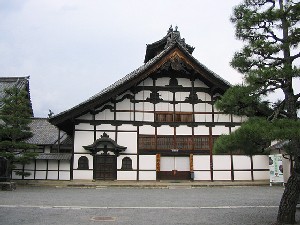
Shokokuji
Torio’s perspective is well illustrated by the following excerpt from a newspaper editorial he wrote for The Japan Daily Mail in 1890:
The adoption of the [Occidental] principles of liberty and equality in Japan would vitiate the good and peaceful customs of our country, render the general disposition of the people harsh and unfeeling, and prove finally a source of calamity to the masses. . . . Though at first sight Occidental civilization presents an attractive appearance, adapted as it is to the gratification of selfish desires, yet, since its basis is the hypothesis that men’s wishes constitute natural laws, it must ultimately end in disappointment and demoralization. . . . Occidental nations have become what they are after passing through conflicts and vicissitudes of the most serious kind. . . . Perpetual disturbance is their doom. Peaceful equality can never be attained until built up among the ruins of annihilated Western States and the ashes of extinct Western peoples.” (3) [Italics mine]
In 1911, Toyota Dokutan (1840-1917), administrative head of the Myoshinji branch of the Rinzai Zen sect, condemned Japanese socialists and anarchists as follows:
The essence of the Rinzai sect since its founding in this country has been to protect the nation through the spread of Zen. It is for this reason that in front of the central Buddha image in our sect’s temples we have reverently placed a memorial tablet inscribed with the words “May the current emperor live for ten thousand years,” thereby making our temples training centers for pacifying and preserving our country. . . . We make certain that adherents of our sect always keep in mind love of country and absolute loyalty [to the emperor]. . . . that they don’t ignore the doctrine of karma or fall into the trap of believing in the heretical idea of “evil equality” [as advocated by socialists, et al.]. (4)
As Dokutan clearly indicates, underlying the above comments was an interpretation of karma which held that differences in social and economic status were not the result of either social injustice or economic exploitation but were, instead, solely the reward (or punishment) for an individual’s past actions in either this life or past lives.
Dissenting Opinions
Not all Meiji era Buddhists accepted this reactionary understanding of karma, for although few in number, there were those who embraced both Buddhism and various left wing ideologies. One of these was a Soto Zen priest and anarcho-communist by the name of Uchiyama Gudo (1874-1911). A pamphlet he addressed to tenant farmers in 1909 contained the following paragraph:
Is this [your poverty] the result, as Buddhists maintain, of the retribution due you because of your evil deeds in the past? Listen friends, if, having now entered the twentieth century, you were to be deceived by superstitions like this, you would still be [no better than] oxen or horses. Would this please you? (5)
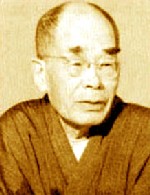
D. T. Suzuki
Perhaps the most famous ‘dissident’ of that era, at least in the West, was D. T. Suzuki (1870-1966). In Outlines of Mahayana Buddhism, published in 1907, Suzuki dismissed advocates of the traditional understanding of karma as no more than “pseudo-Buddhists.” Suzuki continued:
No, the doctrine of karma certainly must not be understood to explain the cause of our social and economical imperfections. The region where the law of karma is made to work supreme is our moral world, and cannot be made to extend also over our economic field. Poverty is not necessarily the consequence of evil deeds, nor is plenitude that of good acts. Whether a person is affluent or needy is mostly determined by the principle of economy as far as our present social system is concerned. (6)
Suzuki’s words raise the interesting question of whether, like Gudo, his break with the traditional understanding of karma, regardless of sect, came as a result of the influence of socialism. One indication of such influence is contained in a second passage in the same book:
As long as we live under the present state of things, it is impossible to escape the curse of social injustice and economic inequality. Some people must be born rich and noble and enjoy a superabundance of material wealth, while others must groan under the unbearable burden imposed upon them by a cruel society.
Unless we make a radical change in our present social organization, we cannot expect every one of us to enjoy an equal opportunity and a fair chance. Unless we have a certain form of socialism installed that is liberal and rational and systematic, there must be some who are economically more favored than others. (7) [Italics mine]
Further indication of socialist influence is contained in the following two passages from letters Suzuki wrote while in the U.S. to his good friend, Yamamoto Ryokichi (1871-1942). On January 6, 1901 Suzuki wrote:
Recently I have had a desire to study socialism, for I am sympathetic to its views on social justice and equality of opportunity. Present-day society (including Japan, of course) must be reformed from the ground up. I’ll share more of my thoughts in future letters. (8)
True to his word, on January 14, 1901 Suzuki wrote Yamamoto:
In recent days I have become a socialist sympathizer to an extreme degree. However, my socialism is not based on economics but religion. This said, I am unable to publicly advocate this doctrine to the common people because they are so universally querulous and illiterate and therefore unprepared to listen to what I have to say. However, basing myself on socialism, I intend to gradually incline people to my way of thinking though I also believe I need to study some sociology. (9)
In addition to introducing us to an almost completely unknown side of Suzuki, the above quotes, together with that of Gudo, raise the even more intriguing question of whether it was then possible to oppose the popular understanding of karma without having first been introduced to socialism, with its understanding of social injustice as stemming from a class-based society in which the ruling classes insure their ongoing wealth and power through the creation and maintenance of unjust social structures rather than the individual morality of members of the working class. For reasons of space, this is a question that cannot be addressed here.
Before leaving Suzuki, it should be noted that his use of the word, “pseudo-Buddhist” is far more controversial than it might first appear. This is because Suzuki’s own Rinzai Zen master, Shaku Soen (1859-1919), clearly belonged to those Suzuki viewed as promoting a socially reactionary view of karma . This is revealed by the following passage in an address Soen delivered to the World’s Parliament of Religions in September 1893 entitled “The Law of Cause and Effect, As Taught by the Buddha”:
We are here enjoying or suffering the effect of what we have done in our past lives. . . . We are born in a world of variety; some are poor and unfortunate, others are wealthy and happy. This state of variety will be repeated again and again in our future lives. But to whom shall we complain of our misery? To none but ourselves!”(10)
Suzuki had to be aware of this passage since it was he who translated the address into English. Given that his own master was among them, it is hardly surprising that Suzuki chose not to name those whom he considered to be pseudo-Buddhists. To have publicly criticized his master was simply unthinkable in the deeply Confucian-tinged Japanese Buddhism of that day (and is so even now, for that matter).
Transitional Usage
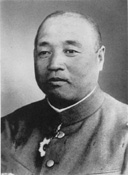
Imamura Hitoshi
Finally, in what might be called a transitional use of karma, we have a military man employing this doctrine to convince his conscripted subordinates that social inequality is nothing to be concerned about, at least in the long term. I refer to Imperial Army General Imamura Hitoshi (1886-1968), who went on to become one of the Imperial Army’s outstanding strategists. As a young officer, Imamura chanced to meet Soto Zen priest Omori Zenkai (1871-1947). Zenkai was no ordinary priest; for over his long career he served as a professor, dean, and finally president of Soto Zen sect-affiliated Komazawa University from 1934-37; administrative head of the Soto sect in 1940-41; and then as chief abbot of both of the Soto sect’s head temples, Sojiji and Eiheiji.
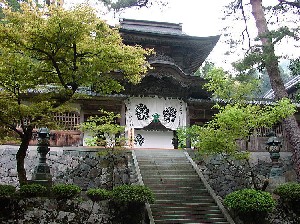
Eiheiji
In 1921 Imamura approached Zenkai with a problem that had been bothering him for some time. Imamura was worried about the demands for democracy and workers’ rights that had been growing in Japan since the end of World War I. According to Imamura, this new democratic way of thinking was even finding its way into the military as evidenced by the fact that lower ranking soldiers had begun to question their superiors about things they found unreasonable in military life and society as a whole. What, Imamura wanted to know, would Zenkai say to soldiers who asked why it was that some Japanese children were born into rich families where they had plenty while “poor children don’t have enough to eat and are unable to seek medical treatment when they get sick”?(11)
Zenkai thought about this question for a moment and then recited a verse from an unnamed Buddhist sutra:
The sun in the heavens has no self,
Flowers and branches have their order. (12)
In other words, natural phenomena like the sun play no favorites, providing life-giving warmth to all without distinction. Despite this, not all buds on a tree blossom at the same time. That is to say, the buds on the branches on the south side of the tree blossom before those on the north side.
Zenkai claimed the same could be said about human society. If everyone will but wait and work diligently, good fortune will eventually come their way. In fact, Zenkai claimed to have proof of this. He recalled having once trained at a temple that had records on its parishioners going back four hundred years. Looking through these records, he discovered that in cycles of approximately one hundred years, families that had been tenant farmers became small landholders; small landholders became large landowners; and large landholders fell into tenancy. Explain to your soldiers, Zenkai said, “Adversity improves one’s character, while a life of ease tends to make one negligent.” (13)
Imamura was quite taken with Zenkai’s explanation and subsequently often used it in instructing his military subordinates. For example, in 1926 Imamura, then a Lt. Colonel, was sent to Korea, which was a Japanese colony. While there he became concerned about what he regarded as the luxurious lifestyle led by some of his officers and senior enlisted personnel. This lifestyle was made possible because, being stationed outside of Japan proper, higher-ranking personnel were entitled to salary supplements.
Using Zenkai’s words, Imamura warned them that by using their money to purchase luxuries for themselves, instead of saving it for such things as their children’s education, they were denying their children “the chance to blossom.” Imamura noted with satisfaction that a number of his subordinates took his advice to heart and expressed gratitude to him for having shared Zenkai’s teaching. This led Imamura to conclude, “I was overjoyed that the Buddhist virtue of Zen Master Omori had reached from Japan all the way to a rural regiment stationed in Korea.” (14)
If Imamura was “overjoyed” by Zenkai's explanation, one cannot but wonder how much comfort Japan’s then poor children who “don’t have enough to eat” would have found in the Zen master’s words?
Military Usage
Buddhist chaplains accompanied Japanese troops to the battlefield as early as the Sino-Japanese war of 1894-5. Their job was not only to give ‘morale-building’ talks but also to conduct funerals for those who fell in battle, as well as to notify the relatives of the deceased in Japan itself. Even in times of peace the need for chaplains was recognized, with the Nishi (West) Honganji branch of the True Pure Land sect (Jodo-Shinshu), for example, dispatching forty-six priests to more than forty military bases throughout Japan as early as 1902. (15)
In the same year, Nishi Honganji produced a booklet entitled Bushido as part of a series called “Lectures on Spirit” (Seishin Kowa). The connection between the two events is clear in that it was Otani Koen (1850-1903), an aristocrat and the branch’s administrative head, who both dispatched the military chaplains and contributed a foreword to the booklet. Koen explained that its purpose was “to clarify the spirit of military evangelization.”(16)
As its title suggests, Nishi Honganji intended this booklet to provide the doctrinal basis for its outreach to the military. That this outreach had a broader focus than the soldiers themselves can be seen from the inclusion of a concluding chapter entitled “To the Parents and Family of Military Men.” Although in 1902 Japan was at peace, there was an increasing awareness of the possibility of war with Russia. Thus, sectarian leaders like Koen realized that soldiers’ parents and family members would be concerned that their loved ones might die in battle.
The booklet’s author was Sato Gan’ei (1847-1905), a military chaplain as well as clerical head of a second lay-oriented Yuima-kai, this one associated with Nishi Honganji. The military character of this association is clear in that three high-ranking Imperial Army officers were members, each contributing a calligraphic endorsement to the booklet. One of the three, Lt. General Oshima Ken’ichi (1858-1947), later served as Minister of War in two cabinets and Privy Counselor during the Asia-Pacific War.
In his introduction, Gan’ei explained that the purpose of religion in Japan was “to be an instrument of the state and an instrument of the Imperial Household.” More specifically, the government had granted Buddhism permission to propagate the faith in order “to ensure that citizens fulfill their duties [to the state] while at the same time preserving social order and stability.” Gan’ei claimed that religionists like him had been charged with making sure this important task was accomplished. (17)
Yet, what did karma have to do with this? Gan’ei explained the military relevance of this doctrine as follows:
Everything depends on karma. There are those who, victorious in battle, return home strong and fit only to die soon afterwards. On the other hand, there are those who are scheduled to enter the military yet die before they do so. If it is their karmic destiny, bullets will not strike them, and they will not die. Conversely, should it be their karmic destiny, then even if they are not in the military, they may still die from gunfire. Therefore there is definitely no point in worrying about this. Or, expressed differently, even if you do worry about it, nothing will change. (18)
As the preceding quotation reveals, there can be no question here of soldiers dying because of the mistaken decisions made by their political or military leader(s). As Gan’ei tirelessly pointed out, the Imperial military was under the direct control of its commander-in-chief, His Majesty the Emperor, whose “bountiful benevolence cannot fail but bring tears of gratitude to the eyes of all parents and family members.” (19)
Thus, a soldier’s death is attributable solely to the karma of that particular soldier. In short, like the physically impaired in the Lotus Sutra, he had it coming to him, and there was nothing that the soldier or his loved ones, let alone his military superiors or even the emperor, could do to change that.
Shaku Soen
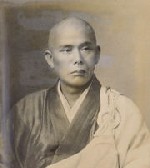
Shaku Soen
Returning to Soen once again, we find this renowned abbot of Kamakura’s Engakuji monastery actively involved in assuaging the grief of those left behind as a result of the Russo-Japanese War of 1904-5. Soen was better acquainted with the realities of war than most; he had personally gone to the battlefield as a chaplain attached to the headquarters of the First Army Division commanded by His Imperial Highness Prince (and General) Fushiminomiya Sadanaru (1858-1925). In a book published in 1906 entitled Sermons of a Buddhist Abbot, Soen explained his motivation for having become a chaplain:
I wished to have my faith tested by going through the greatest horrors of life, but I also wished to inspire, if I could, our valiant soldiers with the ennobling thoughts of the Buddha, so as to enable them to die on the battlefield with the confidence that the task in which they are engaged is great and noble. I wished to convince them of the truths that this war is not a mere slaughter of their fellow-beings, but that they are combating an evil, and that, at the same time, corporeal annihilation really means a rebirth of [the] soul, not in heaven, indeed, but here among ourselves. (20)
While these words were clearly meant for soldiers, not their families, we find yet another invocation of karma to assuage the fear of death. Soen found a positive element in this doctrine that Gan’ei had overlooked, i.e. the certainty that death would lead to subsequent rebirth in human form, not as punishment for past misconduct, but as a reward for the soldier’s sacrifice in combating evil. Soen explained the significance of this process as follows:
There is but one great spirit, and we individuals are its temporal manifestations. We are eternal when we do the will of the great spirit; we are doomed when we protest against it in our egotism and ignorance. We obey, and we live. We defy, and we are thrown into the fire that quencheth not. Our bodily existences are like the sheaths of the bamboo sprout. For the growth of the plant it is necessary to cast off one sheath after another. It is not that the body-sheath is negligible, but that the spirit-plant is more essential and its wholesome growth of paramount importance. Let us, therefore, not absolutely cling to bodily existence, but when necessary, sacrifice it for something better. For this is the way in which the spirituality of our being asserts itself. (21)
In promising soldiers the possibility of life “eternal,” Soen sounds almost Christian in his approach. However, Soen did not place the war dead in a Christian heaven, but asserted, true to the traditional understanding of karma, that “what we actually see around us is that the departed spirits are abiding right among ourselves.” (22) Needless to say, this was an attractive possibility not only to soldiers facing death on the battlefield but to their family members as well. Yet, Soen was clearly not overly concerned about consoling the war bereaved, for he concludes his discussion by noting:
As for us who are left behind, no superfluous words are in place, only we must not disgrace the honor and spirit of the dead who have solemnly bequeathed to us their work to perfect. Mere lamentation not only bears no fruit, it is a product of egoism, and has to be shunned by every enlightened mind and heart.” (23)
In describing lamentation at the time of death of a loved one as “a product of egoism,” Soen is taking an impeccably Buddhist position. Yet, one cannot help but wonder if he would have dared direct those words to the families of soldiers who had just received notification of their loved one’s death. After all, as Soen would be the first to admit, not all Japanese were possessed of an “enlightened mind and heart.” Who would address the spiritual needs of the ‘unenlightened’?
Yamada Reirin
In Soto Zen scholar-priest Yamada Reirin (1889-1979), we find a somewhat ‘softer’ Zen voice addressing the question of war bereavement. In postwar years Reirin served as the abbot of Zenshuji temple in Los Angeles, president of Komazawa University, and the seventy-fifth head of Eiheiji monastery. Reirin’s wartime comments are included in a 1942 book entitled Evening Talks on Zen Studies (Zengaku Yawa). Together with his praise for the imperial military’s “wonderful fruits of battle,” Reirin, like both Gan’ei and Soen before him, found the key to Buddhist consolation in the doctrine of karma.
As the following passage reveals, Reirin sought to offer karmic hope not so much to soldiers on the battlefield as to the families they left behind:
The true form of the heroic spirits [of the dead] is the good karmic power that has resulted from their loyalty, bravery, and nobility of character. This will never perish. . . . The body and mind produced by this karmic power cannot be other than what has existed up to the present. . . . The loyal, brave, noble, and heroic spirits of those officers and men who have died shouting, “May the emperor live ten thousand years!” will be reborn right here in this country. It is only natural that this should occur. (24)
Whereas Soen had gone to the battlefield to inspire soldiers to willingly sacrifice their lives in a cause that was “great and noble,” Reirin, writing for a home audience, hoped to console grieving family members with the thought that every baby born in Japan was potentially their lost loved one.
Reirin did deny, however, that the bereaved would ever recognize which particular child was theirs. Yet there could be no doubt that the “good karmic power” (zengoriki) the heroic spirit had acquired through death on the battlefield would result in rebirth in Japan. That much was “absolutely certain” (hitsujo). Given this, what need was there for grief?
Tomomatsu Entai
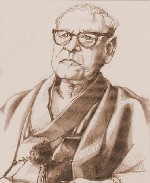
Tomomatsu Entai
Perhaps the most ambitious Buddhist attempt to console grieving survivors was provided by Tomomatsu Entai (1895-1973), a noted Pure Land sect scholar-priest. Entai’s comments were contained in an eighty-two-page booklet published on 25 December 1941, only days after Japan’s attack on Pearl Harbor. Entitled A Reader for Bereaved Families (Izoku Tokuhon), the booklet was published by the Imperial Army’s “Military Relief Department” (Juppei-bu).
The Buddhist character of the booklet is clear from its subtitle: “Turning Illusion into Enlightenment (Tenmei Kaigo). Section headings reveal a similar influence, e.g. “Turning the Mind,” “Nirvana,” and, of course, “Karma.” This does not mean, however, that there was no Shinto influence, for according to Entai, “Following their death in battle, your children or husbands are no longer ordinary human beings but have, at a single bound, become [Shinto] gods and Buddhas. . .” (25)
Similarly, there were the inevitable references to Japan’s divine emperor. Entai reinforced conclusions that had a profound effect on the way the Japanese people viewed the war at the time and even today:
There are those who say that it is no more than chance that someone dies on the battlefield, or becomes a widow early in life, or becomes an orphan without having seen their father’s face. However, there is not so much as a single bullet flying from the enemy that happens by chance. It is definitely the work of karma, for it is karma that makes it strike home. . . . Your husband died because of his karma. . . . It was the inevitability of karma that caused your husband’s death. In other words, your husband was only meant to live for as long as he did. In those bereaved who have recovered their composure, one sees the realization that their husband’s death was due to the consistent working of karma. No one was to blame [for his death] nor was anyone in the wrong. No one bears responsibility for what happened, for it was simply his karma to die. (26)
Even today the world struggles to understand why many Japanese have had such enormous difficulty in coming to grips with their war responsibility. At least part of the explanation is to be found in the doctrine of karma as formulated by the likes of Entai, who asserted that “no one was to blame nor was anyone in the wrong.”
On the surface, karma appears to place a premium on the ethical behavior of the individual. Yet, when it comes to evaluating the behavior of a society’s leaders who decide on war or peace, it has almost nothing to say. Instead, individuals get no more or less than what they deserve. How could the war responsibility of Japanese leaders be determined in the face of the “consistent working of karma”?
Conclusion
In An Introduction to Buddhist Ethics, Peter Harvey claims that in Buddhism karma is not a fatalistic concept. (27) If this is true, one is forced to ask, who forgot to inform millions of Buddhists down through the ages how karma actually worked, not least of all in modern Japan? Did all of these Buddhists ‘get it wrong’? Or is this simply one of the ‘subtleties’ of Buddhist doctrine that somehow got ‘lost along the way’?
One would like to believe that Harvey is right in his
interpretation, and, at least in theory, he is. That is to say, a close reading of Buddhist texts reveals that karma
is only one of five rules or processes (Skt., niyama),
that cause effects. The five are: 1) Karma
Niyama—Consequences of one's actions; 2) Dharma Niyama—Laws
of nature; 3) Utu Niyama—Seasonal changes and climate; 4)
Bija Niyama—Genetic inheritance; and 5) Citta
Niyama—Processes of consciousness. Thus it is clearly mistaken to
claim that all occurrences are no more or less than the result of karma.
Similarly, the Theravadan school of Buddhism has long held that it is a
“wrong view” (Pali, pubbekatahetuvada) to hold that all
happiness and suffering are determined by previous karma.
Further, a growing number of
contemporary Buddhist leaders frankly admit that the traditional
attribution of all misfortune to an individual’s karma is both inadequate
and unjust, not least of all because it leads to social apathy and a lack
of social engagement. This in turn has led to an awareness of what these
leaders identify as either “collective karma” or “social karma.”
The noted Thai Buddhist
scholar, Ven. Dhamma-pitaka, for example, points to government corruption,
drugs, environmental degradation and authoritarianism as examples of
social karma. He critiques authoritarianism as resulting from the desire
to subordinate others in order to profit oneself, desires that Buddhism
has long sought to eliminate. Controversially, however, Dhamma-pitaka
claims that because an authoritarian system cannot be maintained by just
one person, “Everyone is karmically responsible.” (28) Unfortunately, this
sounds suspiciously like a collective version of “blame the
victim(s).”
Be that as it may, in an era when socially oppressive, if not fanatical, aspects of religion are all too visible, a bleak future awaits Buddhism should its leaders fail to disavow the traditional understanding of karma as a rationale for oppression and social discrimination.
Or as Uchiyama Gudo so insightfully expressed it:
Listen friends, if, having now entered the twentieth century, you were to be deceived by superstitions like this, you would still be [no better than] oxen or horses. Would this please you?
Brian Victoria is the
director of the Antioch College Buddhist Studies Program in Japan and
Professor of Comparative Literature and Religion. He trained at the Soto
Zen monastery of Eiheiji and is a fully ordained priest. His books include
Zen
at War and Zen
War Stories.
Notes
(1) Bunno Kato. The Threefold Lotus Sutra (Tokyo: Kosei, 1989), p. 343.
(2) For further discussion, see Brian Victoria, Zen at War (New York: Weatherhill, 1997), pp. 41-42.
(3) Quoted in Victoria, Zen at War, p. 199.
(4) Ibid., p. 50.
(5) Ibid., p. 43.
(6) D.T. Suzuki. Outlines of Mahayana Buddhism (New York: Schocken Books, 1963), p. 189.
(7) Ibid., p. 191.
(8) D.T. Suzuki. Suzuki Daisetsu zenshu, Vol. 36 (Tokyo: Iwanami Shoten, 1971), p. 204.
(9) Ibid., p. 206.
(10) Quoted in Wayne Yokoyama, "Two Addresses by Shaku Soen," in The Eastern Buddhist (New Series), Vol. 26/2 (1993), pp. 136-37.
(11) Quoted in Brian Victoria, Zen War Stories (London: RoutledgeCurzon, 2003), p. 111.
(12) Ibid., p. 111.
(13) Ibid., p. 111.
(14) Ibid., p. 112.
(15) Ibid. , pp. 150-162.
(16) Ibid., p. 150.
(17) Ibid., p. 151.
(18) Ibid., p. 153.
(19) Ibid., p. 153.
(20) Quoted in Victoria, Zen at War, p. 26.
(21) Ibid., pp. 27-28.
(22) Ibid., p. 28.
(23) Ibid., p. 28.
(24) Ibid., p. 132.
(25) Quoted in Victoria, Zen War Stories, p. 156.
(26) Ibid., p. 159.
(27) See Peter Harvey. An Introduction to Buddhist Ethics (Cambridge: Cambridge University Press, 2000), pp. 23-24.
(28) Quoted in Suwanna Satha-Anand, “Karma as Moral Justice in Thai Buddhism” in Manusya: Journal of Humanities (Special Issue), Vol. 4 (2002), p. 81.